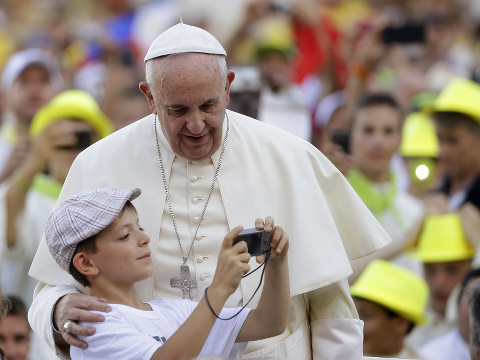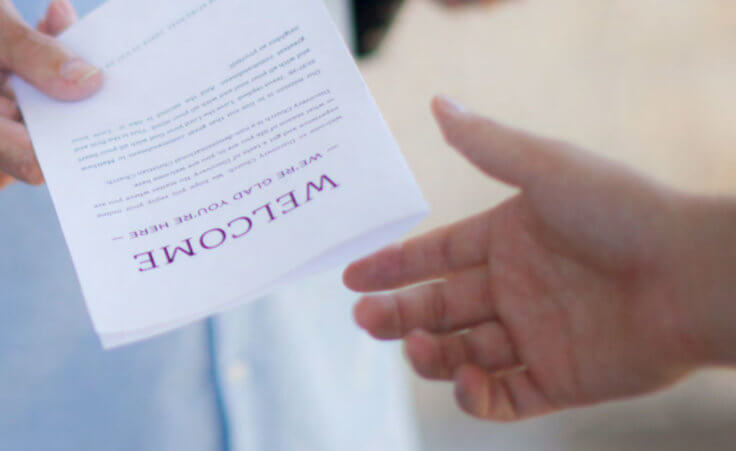
On March 13, 2013, Argentina’s Jorge Mario Bergoglio became the 266th Pope of the Roman Catholic Church. He has since has been named Time magazine’s “Person of the Year.” Esquire named him their “Best-Dressed Man” for his simple vestments. Rolling Stone featured him on their January 2014 cover. Fortune ranked him as number one in their list of 50 greatest leaders. Forbes designated him the fourth most powerful person in the world, the only non-political figure in their ranking.
The Pope Francis Center for the Poor has been opened in the Philippines. Two biographical films of the pope are now in production. Argentina recently announced that its new soccer stadium will be named after Pope Francis.
And his recent tour of the United States was an astounding success.
The pope visited Washington, D.C., New York City, and Philadelphia over six days. He met with victims of sexual abuse, kissed a boy with cerebral palsy, and prayed for victims of the 9/11 attacks.
Some 15,000 people gathered to see him outside the White House. More than 80,000 followed his procession through New York City’s Central Park. Hundreds of thousands turned out for his final Mass in Philadelphia. He dominated headlines and news coverage during his stay.
What secrets help explain Pope Francis’s leadership success? What does that success say about our culture?
A humble man
Paul Vallely, a writer for The Atlantic, recently visited a place he calls, “where Pope Francis learned humility.”i The location is Cordoba, Argentina. It played a largely unreported but enormously strategic role in Pope Francis’s spiritual and personal development.
Here’s the story.
Jorge Mario Bergoglio was a superstar among Argentine Catholics. In 1973, at the age of 36, he was appointed head of all Jesuits in the country. It was a difficult time for the nation, with political divisions and widespread corruption. Catholics were split over liberation theology and other contemporary trends.
By his own admission, however, Bergoglio’s leadership style made things worse. What he later called “my authoritarian and quick manner of making decisions” led to serious divisions within the Jesuit community. By 1990, two-thirds of Argentina’s Jesuits were opposed to his leadership. One told Vallely, “He drove people really crazy with his insistence that only he knew the right way to do things.”
Their solution: exile.
Bergoglio was sent to live in the Jesuit residence at Cordoba, Argentina. For two years he was not permitted to say Mass in public in the Jesuit church. He could hear confessions, but his correspondence was controlled and his supporters were told not to contact him. Bergoglio later called this “a time of great interior crisis.”
The priest who emerged was more humble, servant-hearted, and people-centered than ever before. He learned that caring for hurting souls was the Church’s primary responsibility, and that her leaders must lead with compassion.
He began concluding every conversation by asking the other person to pray for him (a practice he continues as pope). Even when he later became archbishop of Argentina, he chose to live in simple quarters, ride public transportation, and cook his own meals. He made people the center of his concern and ministry.
A humble pope
When Cardinal Bergoglio was chosen pope, his first act was to receive his fellow cardinals as their peer, standing on their level. For his first public appearance, he wore a white cassock, the ordinary papal dress, rather than the more formal red, ermine-trimmed mozzetta used by previous popes.
He chose to wear the same iron pectoral cross that he had worn as Archbishop of Buenos Aires, rather than the gold one used by his papal predecessors. His first public act was to bestow the Urbi et Orbi blessing on pilgrims standing en masse in St. Peter’s Square. But before he blessed them, he asked them to pray for his predecessor, Pope Benedict XVI, and for himself.
Pope Francis then chose to remain in the Vatican guest house rather than moving to the official papal residence in the Apostolic Palace. He is the first pope since Pius X (who died in 1914) to live outside the spacious papal apartments. And he travels around the Vatican in a donated 1984 Renault with 190,000 miles.
On the first Holy Thursday following his election, Francis participated in the traditional Maundy Thursday foot-washing service, choosing 12 people (symbolizing the 12 disciples). However, the 12 he chose were juvenile offenders from Rome’s Casal del Marmo detention facility.
He washed and kissed their feet, then told them, “Washing your feet means I am at your service.” He then encouraged them to “help one another. This is what Jesus teaches us.” Two of the twelve were female, making Francis the first pope ever to wash the feet of a woman. In addition, two of the juvenile offenders were Muslims. When one young man asked why he had chosen them, Pope Francis replied that the gesture came “from my heart. Things from the heart don’t have an explanation.” By washing their feet, he earned the right to preach the gospel to their souls.
From the first day of his papacy to today, Francis has sought to serve with compassion. He has adopted a humble posture that admits that we are all sinners in need of a Savior. And his humility has endeared him to the world.
Humble leaders
Pope Francis offers an essential leadership model for the postmodern world. Our culture rejects the notion of absolute truth and authoritarian leadership. We have been taught that all humans are motivated by the “will to power” (Nietzsche), and that leaders are especially corrupted by this motivation.
As a result, leaders must today earn the right to lead. We do so by serving those we would lead, so that they know that our leadership is intended to serve their best interests. When they believe that we care for them as people, they may follow us as their leader.
Oswald Sanders, in his now-classic Spiritual Leadership, claims that “true greatness, true leadership, is found in giving yourself in service to others, not in coaxing or inducing others to serve you.”ii Max DePree, the former CEO of Herman Miller and author of bestselling leadership literature, defines leadership:
As the axiom has it, people don’t care how much we know until they know how much we care.
The power of compassion
Mother Teresa defined loneliness as the great epidemic of our culture. Paradoxically, the more social media dominates our culture, the more isolated we feel. We create online personas to mask our true identity. We project to others the person we wish to be, then try to live up to this ideal.
All the while, we yearn for someone to accept us and care for us as we are. Such compassion feeds the hunger of our souls and distinguishes true servant leaders from the rest.
Pope Francis is famous for his compassion. After he embraced a man with a severely disfiguring disease, pictures of the encounter went viral. He made headlines when he halted the papal motorcade to kiss a physically-challenged young woman.
He encourages fellow believers to manifest Christ’s love in theirs. The pope tweeted, “Lord, teach us to step outside ourselves. Teach us to go out into the streets and manifest your love.” Later he echoed the same message, “True charity requires courage: let us overcome the fear of getting our hands dirty so as to help those in need.”
Conclusion
Our culture is starved for authenticity and compassion. When we see a man of enormous global power manifesting mercy and grace, we are drawn to him.
Pope Francis follows the example of the One who washed his disciples’ feet and instructed them to do the same. His popularity fulfills Jesus’ promise, “By this all people will know that you are my disciples, if you have love one for another” (John 13:35).
Let us go and do likewise, to the glory of God.
i. Paul Vallely, “Where Pope Francis Learned Humility,” The Atlantic, August 23, 2015 (https://www.theatlantic.com/international/archive/2015/08/pope-francis-cordoba-exile-humble/402032/, accessed 30 September 2015).
ii. J. Oswald Sanders, Spiritual Leadership (Chicago: Moody Press, 1994), 15.
iii. Max DePree, Leadership Is An Art (New York: Dell, 1989) 11.












